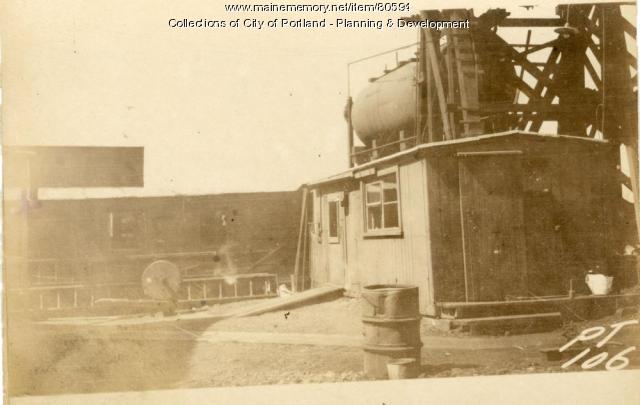Keywords: point
Item 1490
Pemaquid Point, August 26, 1869
Contributed by: Maine Historical Society Date: 1869 Location: Bristol Media: Photographic print
Item 191
Martin's Point, Portland, ca. 1850
Contributed by: Maine Historical Society Date: circa 1850 Location: Portland Media: Oil on panel
Item 74588
Storehouse, Thompsons Point, Portland, 1924
Owner in 1924: The Portland & Ogdensburg Railroad Use: Storehouse
Item 74953
Storehouse, Thompsons Point, Portland, 1924
Owner in 1924: The Portland & Ogdensburg Railroad Use: Storehouse
Item 116273
Hancock Point Chapel, Hancock, 1898
Contributed by: Maine Historical Society Date: 1898 Location: Hancock Client: Hancock Point Chapel Society Architect: John Calvin Stevens
Item 109857
Plans for Bay Point Hotel, Rockland, 1889-1902
Contributed by: Maine Historical Society Date: 1889–1902 Location: Rockland Client: H. Ricker and Sons Architect: George M. Coombs; Coombs and Gibbs Architects
Exhibit
Rebecca Usher: 'To Succor the Suffering Soldiers'
Rebecca Usher of Hollis was 41 and single when she joined the Union nursing service at the U.S. General Hospital at Chester, Pennsylvania. Her time there and later at City Point, Virginia, were defining experiences of her life.
Exhibit
Colonial Cartography: The Plymouth Company Maps
The Plymouth Company (1749-1816) managed one of the very early land grants in Maine along the Kennebec River. The maps from the Plymouth Company's collection of records constitute some of the earliest cartographic works of colonial America.
Site Page
John Martin: Expert Observer - Picnic, Fort Point Light, and Fort Pownal, 1865
"Picnic, Fort Point Light, and Fort Pownal, 1865 Contributed by Maine Historical Society and Maine State Museum Description On page 122 of…"
Site Page
Old Berwick Historical Society
View collections, facts, and contact information for this Contributing Partner.
Story
Learning to fly and instructing cadets at West Point during WWII
by Vera Cleaves
West Point during World War II
Story
The Point
by Norma K. Salway
In the summer, on the eastern shore of Songo, kids dove from a leaning tree
Lesson Plan
Longfellow Studies: An American Studies Approach to Henry Wadsworth Longfellow
Grade Level: 6-8, 9-12
Content Area: English Language Arts, Social Studies
Henry Wadsworth Longfellow was truly a man of his time and of his nation; this native of Portland, Maine and graduate of Bowdoin College in Brunswick, Maine became an American icon. Lines from his poems intersperse our daily speech and the characters of his long narrative poems have become part of American myth. Longfellow's fame was international; scholars, politicians, heads-of-state and everyday people read and memorized his poems. Our goal is to show that just as Longfellow reacted to and participated in his times, so his poetry participated in shaping and defining American culture and literature.
The following unit plan introduces and demonstrates an American Studies approach to the life and work of Longfellow. Because the collaborative work that forms the basis for this unit was partially responsible for leading the two of us to complete the American & New England Studies Masters program at University of Southern Maine, we returned there for a working definition of "American Studies approach" as it applies to the grade level classroom. Joe Conforti, who was director at the time we both went through the program, offered some useful clarifying comments and explanation. He reminded us that such a focus provides a holistic approach to the life and work of an author. It sets a work of literature in a broad cultural and historical context as well as in the context of the poet's life. The aim of an American Studies approach is to "broaden the context of a work to illuminate the American past" (Conforti) for your students.
We have found this approach to have multiple benefits at the classroom and research level. It brings the poems and the poet alive for students and connects with other curricular work, especially social studies. When linked with a Maine history unit, it helps to place Portland and Maine in an historical and cultural context. It also provides an inviting atmosphere for the in-depth study of the mechanics of Longfellow's poetry.
What follows is a set of lesson plans that form a unit of study. The biographical "anchor" that we have used for this unit is an out-of-print biography An American Bard: The story of Henry Wadsworth Longfellow, by Ruth Langland Holberg, Thomas Y. Crowell & Company, c1963. Permission has been requested to make this work available as a downloadable file off this web page, but in the meantime, used copies are readily and cheaply available from various vendors. The poem we have chosen to demonstrate our approach is "Paul Revere's Ride." The worksheets were developed by Judy Donahue, the explanatory essays researched and written by the two of us, and our sources are cited below. We have also included a list of helpful links. When possible we have included helpful material in text format, or have supplied site links. Our complete unit includes other Longfellow poems with the same approach, but in the interest of time and space, they are not included. Please feel free to contact us with questions and comments.
Lesson Plan
Primary Sources: Museum Practices for Students
Grade Level: K-2, 3-5
Content Area: Social Studies
Included here are some basics about general museum etiquette and ways to enable your students a greater understanding of museums, artifacts and their significance in illustrating history.





















